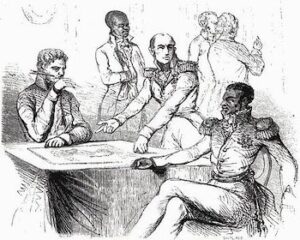
The Haitian Indemnity
*On this date in 1825, Haiti signed the Ordinance of King Charles X.
Often called the Haiti Indemnity, this was a controversial agreement between Haiti and France where France demanded an indemnity of 150 million francs from Haiti in claims over property, including Haitian slaves. 1791, France lost colonial control of the island through the Haitian Revolution. The Ordinance demanded a return for diplomatic recognition, the debt removing $21 billion from the Haitian economy.
The first annual payment alone was six times Haiti's annual revenue. The payment was later reduced to 90 million francs in 1838, equivalent to $32,535,940,803 in 2022, with Haiti paying about 112 million francs in total. The Haitians wanted the French to recognize the Spanish part of the island as part of Haitian territory. However, the French flatly ignored this request. France returned the Spanish part of the island to Spain in the Treaty of Paris of 1814, which annulled the Treaty of Basel of 1795.
As a show of force, the ship La Circe and two men-of-war arrived at Port-au-Prince on July 3, 1825. Soon after, more warships arrived in Haiti. A total of fourteen French warships equipped with 528 cannons presented demands that Haiti compensate France for its loss of slaves twenty-one years after Haiti declared independence in 1804. In addition to the payment, Charles of France ordered Haiti to provide a fifty percent discount on French import duties, making payment to France more difficult.
On this date in 1825, the Senate of Haiti signed an agreement to pay indemnity to France. Due to the unrealistic demands pushed by France, Haiti took out large loans from French bank Crédit Industrial et Commercial, enriching the bank's shareholders. Though France received its last indemnity payment in 1888, the United States funded the acquisition of Haiti's treasury in 1911 to receive interest payments related to the indemnity. In 1922, the rest of Haiti's debt to France was moved to be paid to American investors. It took until 1947 – about 122 years – for Haiti to finally pay off all the associated interest to the National City Bank of New York (now Citibank). Payments of interest and down payments totaled a significant share of Haitian GDP, constraining the use of domestic financial funds for infrastructure and public services.
In 2016, the Parliament of France repealed the 1825 ordinance of Charles X, though France has offered no reparations. These debts have been denounced by some historians and activists as Guilty of Haiti's Poverty today and a case of odious debt, although others point to the lack of growth relative to the neighboring Dominican Republic, even since the debt was repaid, as evidence for other factors. In 2022, The New York Times published a dedicated investigative series.
In 2024, corruption, impunity, and poor governance, together with increasing levels of gang violence, have brought the Caribbean nation’s state institutions “close to collapse,” with 1500 people killed.